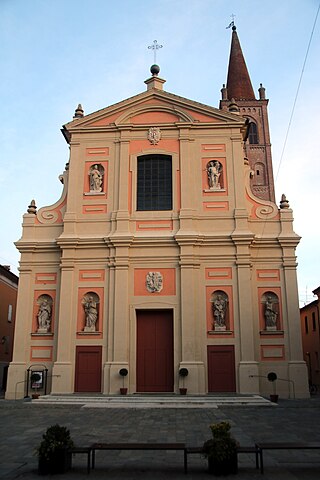Related Research Articles

The Basilica of Saint Mary Major, or church of Santa Maria Maggiore, is a Major papal basilica as well as one of the Seven Pilgrim Churches of Rome and the largest Catholic Marian church in Rome, Italy.

Bernardo Clesio was an Italian Cardinal, bishop, diplomat, humanist and botanist.

Lorenzo Sabbatini or Sabatini, Sabattini or Sabadini, sometimes referred to as Lorenzino da Bologna, was an Italian painter of the Mannerist period from Bologna.

The Archdiocese of Bologna is a Latin Church ecclesiastical territory or archdiocese of the Catholic Church in Northern Italy. The cathedra is in the cathedral church of San Pietro, Bologna. The current archbishop is Cardinal Matteo Zuppi, who was installed in 2015.

Pieve di Cento is a comune (municipality) in the Metropolitan City of Bologna in the Italian region Emilia-Romagna, located about 25 kilometres (16 mi) north of Bologna.

Girolamo Siciolante da Sermoneta began his career as an Italian Mannerist painter but later adopted the reformist naturalism of Girolamo Muziano in the 1560s and 70s. He was active in Rome in the mid 16th century.

Cesare Nebbia (c.1536–c.1614) was an Italian Mannerist painter from Orvieto.

Orazio Samacchini was an Italian painter of the late-Renaissance and Mannerist style, active in Rome, Parma, and his native city.

Nosadella, full name Giovanni Francesco Bezzi, was an Italian painter and draftsman, active during the Mannerist period, mainly in Bologna. He appears to have traveled to Rome.

Filippo Zaniberti (1585–1636) was an Italian painter of the late Mannerist period.
Giacomo Stella was an Italian painter of the late-Renaissance or Mannerist period, active mainly in Rome.

Biagio Pupini was an Italian painter of the Renaissance period, active mainly in his native city of Bologna. He was known to be active mainly during 1530–1540. He was a disciple of Francesco Francia. He completed paintings for the church of San Giuliano, Basilica of San Giacomo Maggiore, and the church of Santa Maria della Baroncella.

Sebastiano Brunetti was an Italian painter active in his native Bologna. He first trained with Lucio Massari, then Guido Reni. He painted a Guardian Angel for the church of Santa Maria Maggiore at Bologna, and a Holy Family for the church of San Giuseppe Sposo, and for Santa Margherita, a Mary Magdalen praying in the Desert.
Antonio Dardani (1677–1735) was an Italian painter of the Baroque period, mainly in his native Bologna..

Sante Cattaneo or Santo Cattaneo was an Italian painter of the Neoclassic period, mainly active in Brescia.

Giovanni Zanardi was an Italian painter of quadratura during the late Baroque period.
Antonio Rolli or Roli (1643–1695) is an Italian painter active painting quadrature during the Baroque period, mainly in his native Bologna.

The Church of Santa Maria Maggiore is an important place of worship in the city of Trento, and the site of the Third Session of the Council of Trent. It was built by Antonio Medaglia on the model of the basilica of Sant'Andrea in Mantua, at the wish of the Prince-Archbishop Bernardo Clesio. In November 1973 Pope Paul VI accorded it the status of minor cathedral.

Crucifixion with Saints or Crucifixion with Mourners and Saints Bernardino of Siena, Francis of Assisi and Petronius is a 1583 oil on canvas, now in the church of Santa Maria della Carità in Bologna. The work was originally sited in the Macchiavelli chapel in San Nicolò di San Felice, Bologna, next to Santa Maria della Carità, which was destroyed by bombing during the Second World War. It was then temporarily moved to the Soprintendenza di Bologna and finally to its current home.
References
- ↑ "The Papal Basilica of Santa Maria Maggiore". Archived from the original on 20 March 2010.
- Marchese Antonio Bolognini Amorini (1843). Vite de Pittori ed Artifici Bolognesi. Tipi Governative alla Volpe ed Nobili; Oxford library digitized June 26, 2006. pp. 100–102.